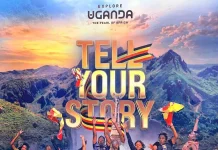Kasubi tombs are the historical burial grounds of the Kings of Buganda located 5 kilometers northwest of Kampala city. The tombs cover an area of 26 hectares of the Kasubi hillside. Originally the tombs were established as the agricultural land that was farmed using the traditional techniques. The site is one of the major spiritual and cultural sites of the Baganda where their traditional and cultural practices have been preserved. The Kasubi tombs are also religious place for the kingdom where most of the rituals are performed by the royal family. The site represents a place where communication links with the spiritual world are maintained.
The site was originally built in 1882 by Kabaka Muteesa I as his royal palace. After his death in 1884, it was converted into his tomb, marking the beginning of its use as a royal burial ground.
In 2001, the Kasubi Tombs were inscribed as a UNESCO World Heritage Site. The site was recognized for its cultural significance as a unique representation of the Ganda traditions and its continued role in spiritual practices and its outstanding example of traditional architecture.
On March 16, 2010, the main tomb structure was severely damaged by a fire. The loss was a cultural tragedy for Uganda. However, the government, UNESCO, and local communities committed to its restoration, emphasizing its importance to the nation and the world. Following the fire, extensive efforts were made to rebuild the tombs using traditional methods. The restoration aimed to preserve the integrity of Ganda craftsmanship and respect the site’s sacredness.
Beyond its physical construction, the tombs hold profound spiritual significance. They serve as a sacred space where the spirits of the Kabakas are believed to reside, acting as intermediaries between the Baganda people and the spiritual realm. The tombs are also a site for traditional rituals, where Baganda priests and royal family members conduct ceremonies to honor the Kabakas and seek blessings.
The Burial Grounds for Four Kabakas
The Kasubi Tombs house the remains of four Buganda kings, each of whom played a significant role in the history and development of the Buganda Kingdom
Muteesa I (1837–1884): The first Kabaka to be buried at Kasubi, Muteesa I is remembered for opening up Buganda to outside influences, including Christianity and Islam, while maintaining the kingdom’s traditions.
Mwanga II (1867–1903): Mwanga II, Muteesa’s son, ruled during a tumultuous period marked by the arrival of European colonizers and missionaries. He is also remembered for his resistance to British colonial rule, which led to his exile in the Seychelles, where he died.
Daudi Chwa II (1896–1939): Daudi Chwa II’s reign saw the formal establishment of British colonial administration in Buganda, and he played a key role in negotiating Buganda’s position within the Protectorate.
Edward Muteesa II (1924–1969): The last Kabaka to be buried at Kasubi, Muteesa II was both a traditional ruler and the first President of independent Uganda. His leadership was marked by struggles between his role as Kabaka and his position in Ugandan politics.
Structure of the Kasubi Tombs
The Kasubi Tombs are an outstanding example of traditional Ganda architecture, with the main building, Muzibu Azaala Mpanga, being the most prominent and significant structure within the site. The layout and structure of the tombs are deeply symbolic and reflect the cultural and spiritual beliefs of the Baganda people.

The central structure of the Kasubi Tombs, known as Muzibu Azaala Mpanga, is an architectural marvel. It is a large circular house made of natural materials, including wood, reed poles, and thatch. The thatched dome-shaped roof is supported by 52 rings of reed poles, which symbolize the 52 Ganda clans. Its design reflects the Baganda’s sophisticated construction techniques and deep connection to their natural environment. Inside the building, the tombs of the Kabakas are concealed behind a bark cloth curtain, maintaining the sacredness of the site. The structure is divided into sections, with sacred spaces reserved for the spirits of the Kabakas and areas for rituals performed by appointed caretakers, known as Baluŭzzi.
The Gatehouse (Bujjabukula) is the entry point to the tombs, serving as a ceremonial gateway. It is traditionally constructed with wooden poles and thatch, symbolizing the transition from the outside world into the sacred grounds of the Kabakas.
The Courtyard (Olugya) is a large open area that serves as a gathering place for ceremonies and rituals. It is also where visitors are received and briefed about the significance of the site.
Surrounding the main tomb structure are smaller houses, the House of the Royal Wives (Ekibira) that accommodate the widows of the deceased Kabakas. These houses are an important part of the royal burial tradition, as the widows play a role in maintaining the spiritual connection with the Kabakas.
The Drums House (Ndoga-Obukaba) houses the royal drums, which are used during important ceremonies and rituals. The drums hold cultural significance as they are used to announce events and pay tribute to the Kabakas.
Around the site, there are smaller grave markers and shrines dedicated to other members of the royal family and significant clan leaders. These areas reinforce the spiritual importance of the site and its role as a royal burial ground.












